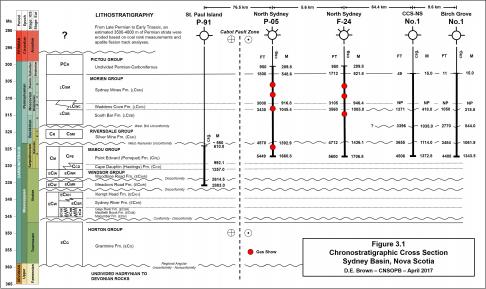Sydney Basin – Well Petrophysical Analysis Summary
As a component of the 2017 Call for Bids, a petrophysical analysis was completed for the five wells within the Sydney Basin:
- Birch Grove No. 1 – Murphy Oil Comapany Ltd., Feb. – May 1968
- North Sydney P-05 – Murphy Oil Company Ltd., Aug. – Sept. 1974
- North Sydney F-24 – Shell Canada Resources Ltd., June – July 1976
- St Paul P-91 – Petro-Canada Inc., Sept. – Dec. 1983
- CCSNS No.1 – CCS Nova Scotia., Nov. 2014
Exploration drilling activities within the Sydney Basin have taken place both onshore and offshore Nova Scotia. The initial phase of exploration began in 1968 with the acquisition of limited seismic data followed by the drilling of a single onshore well, Birch Grove No. 1, by Murphy Oil Canada Ltd. The second phase began in August 1974. Additional seismic and gravity / magnetic data was collected that resulted in the drilling of the first of two additional offshore wells. The Murphy Oil Canada Ltd. North Sydney P-05 well, was intended to evaluate a seismically identified structure, targeting the Mississippian Windsor and Horton groups. According to Murphy Oil reports, initial evaluation of the North Sydney P-05 well did not encounter sufficient hydrocarbon accumulations within the South Bar Formation sandstones to warrant further testing.
Shell Canada, a partner in the P-05 well, returned to the Sydney Basin in 1976 to drill the North Sydney F-24 well. The F-24 well was located only 5.6 kilometers West Southwest of the P-05 well, on the same geological structure and was intended to test the flow potential of the South Bar Formation sandstones encountered in the first well. The final petroleum exploration well drilled in the offshore portion of the Sydney Basin was the Petro-Canada St. Paul P-91 well. Terminated in December 1983, the St. Paul P-91 well was drilled to evaluate the hydrocarbon prospectivity of the Windsor and Horton groups.
The most recent well drilled in the Sydney Basin was drilled onshore, and was not intended to be a petroleum exploration well. Operated by the Carbon Capture and Storage Research Consortium of Nova Scotia, the CCS-NS No. 1 well was drilled to confirm the presence of Horton-aged porous sandstones and evaluate their potential for carbon dioxide injection.
A detailed summary and table of petrophysical properties is provided on an individual basis, and can be found in the Petrophysical Interpretation sections for each well. A chronostratigraphic cross section of all five wells is presented in Figure 3.1, with stratigraphic information in Tables 3.1 and 3.2.


